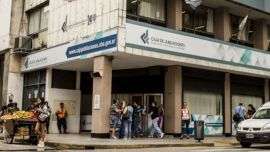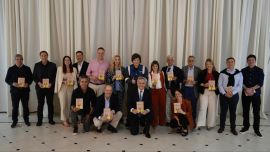If the world’s civilisations were cradled between the Tigris and Euphrates rivers millennia ago, this republic was born in Argentina’s Mesopotamia – before Buenos Aires, the Entre Ríos provincial capital of Paraná was the seat of national government from 1853 to 1862 after the 1853 Constitution was drafted in Santa Fe on the other side of the river. For much of that century the balance of power in Argentina was defined by the ability of Entre Ríos strongman Justo José de Urquiza (the first elected president of the Argentine Confederation, 1854-60) to put some 8,000 horsemen into the field at a moment’s notice in a very different country.
Entre Ríos today takes its turn (based on this series’ criterion of ascending order of electorate magnitude) with almost perfect timing – it will be voting next weekend along with three other provinces (including the next column, Tucumán) among a total of 10 gubernatorial elections due in the upcoming fortnight.
Not much suspense about that result – one reason why Entre Ríos is staying in sequence today instead of being postponed a week for its election eve. The April 14 PASO primary was one of the clearest examples of this year’s general trend of endorsing incumbent provincial governments by convincing margins –in a highly polarised race (with over 90 percent voting for the two main candidates) Peronist Governor Gustavo Bordet romped to a 58.15 percent landslide over veteran Radical Atilio Benedetti with 33.65 percent. In the 2017 midterms these percentages were almost reversed – 53 percent for Benedetti’s list and 38 percent for the Justicialist Front, a turnaround which should deeply worry President Mauricio Macri’s Cambiemos coalition now.
Bordet is all things to all men more than most governors – not only does his electoral umbrella embrace 11 parties (including Kirchnerism and all other splinters of Peronism) but perhaps only Córdoba’s Juan Schiaretti is on smoother terms with Macri among Peronist governors, even joining last year’s presidential tour of Russia, Switzerland and France. Benedetti (who comes from Larroque, which is now the second or even first home of fellow-columnist Andrew Graham-Yooll) has been the top provincial opposition candidate for most of the last decade. Only 8.2 percent of the electorate voted for third parties last April with 4.5 percent shared by three leftist hopefuls.
With such a complete dress rehearsal as PASO and such a lopsided result, who needs opinion polls now (even allowing for the passage of six weeks)?
Entre Ríos is the last province in this series which will be voting for both Houses of Congress in October. The three senators are Pedro Guastavino and Sigrid Kunath for the Victory Front and Alfredo De Angeli (who headed farming resistance to the Kirchnerite export duties in 2008 at both provincial and national level) for PRO/Cambiemos with Alliance for Entre Ríos his official label. Given current trends, the Peronist grip on the two majority senators is unlikely to change. But Cambiemos chances are rather better at Lower House level thanks to four of the nine seats being at stake – the Peronist list would need to improve slightly on Bordet’s 58.15 percent to lay claim to three of these seats with an even split the likeliest outcome. The four outgoing deputies are PRO’s Yanina Gayol and Radical Marcelo Monfort from the government benches together with Peronists Juan Manuel Huss and former two-term Paraná mayor Julio Solanas. Staying put until 2021 are Radicals Benedetti (unless he becomes governor) and Jorge Lacoste together with PRO’s Alicia Fregonese for Cambiemos and Peronists Juan José Bahillo and Mayda Cresto. Apart from Benedetti and Solanas, none of these deputies have made much of a name for themselves.
As one of only four provinces voting for Macri in the first round of 2015 (although he doubled that score in the run-off), Entre Ríos is especially crucial to the President’s re-election hopes. Entre Ríos is something of a bellwether as the only province other than Santa Fe which since 1983 has always voted for the winner of the first round (even Carlos Menem in 2003 although he ducked a hopeless run-off, thus leaving the late Néstor Kirchner president by default).
Before the various power plays of Urquiza (assassinated in his San José palace at the behest of his rival Ricardo López Jordán in 1870), the history of Entre Ríos tended to move as slowly as the rivers between which it flows – centuries of the generally peaceful presence of mostly nomadic indigenous tribes, followed by gradual Spanish penetration in colonial times with Paraná not founded until 1730. The province was transformed by mass European immigration almost immediately following the 1853 Constitution – this was less dominated by Italian and Spanish strains than other parts of Argentina with such communities as the Volga Germans from Russia, the Franco-Swiss of Colón and, perhaps most famously, the East European Jews (the gauchos judios brought over by Baron Hirsch as from 1889) in the belt between Victoria and Basavilbaso. Not so long ago there were parts of Entre Ríos which were bilingual and where Catholics (94.3 percent of Argentina according to the 1970 census) were a small minority.
Apart from Urquiza and López Jordán, the 38 governors in the province’s first century after 1814 included such famous names as the first caudillo Francisco Ramírez, Lucio N. Mansilla and the brutal Pascual Echagüe. The rulers since then (16 elected governors and 18 trustees before 1983, only five governors since) have invariably followed the political mainstream of their times – always Radical whenever elected through to 1943 and Peronists in periods of Peronist presidency (1946-55 and 1973-6). Radical presidencies in 1989 and 1999 were accompanied by a Radical governor in Entre Ríos (Sergio Montiel in both cases) while recent Peronists were three-term Jorge Busti from Concordia, supermarket chain owner Mario Moine (1991-5) under Menem and Sergio Urribarri (2007-15) at the height of Kirchnerism.
The 1.25 million or so people in its 17 departments are not as concentrated in the provincial capital (Paraná with under a quarter of the population or 247,863 according to the 2010 census) as in most other provinces – apart from the second city of Concordia (152,282), Gualeguaychú (83,116) and Concepción del Uruguay (73,729, all 2010 data) are also important with six more cities in the 25-50,000 range. Chicken runs are a distinguishing feature of the agriculture.
Crisscrossed with numerous streams and the characteristic cuchilla ridges between the two broad rivers Paraná and Uruguay with their many islands, the province has varied tourist attractions such as El Palmar national park with its palm trees, Gualeguaychú’s famous carnival and Urquiza’s San José palace. A province which generally goes with the flow.
#19 Entre Ríos
Electorate next Sunday: 1,080,298
Governor: Gustavo Bordet (Peronist)
Senators: Three (2 Peronist, 1 PRO/Alliance Union for Entre Ríos)
Deputies: 9 (5 Cambiemos including
3 Radical and 2 PRO, 4 Peronists)
On the ballot: 3 senators, 4 of 9 deputies


























Comments